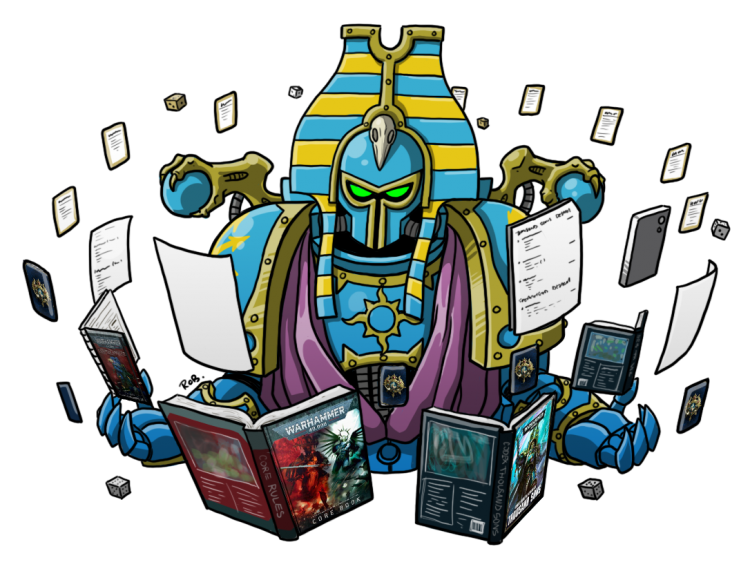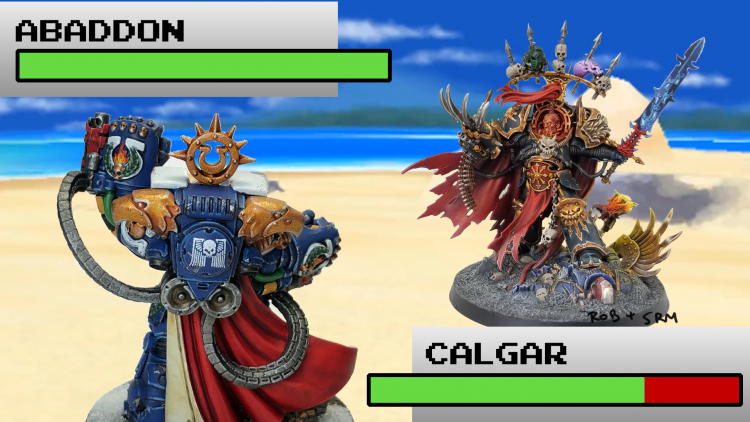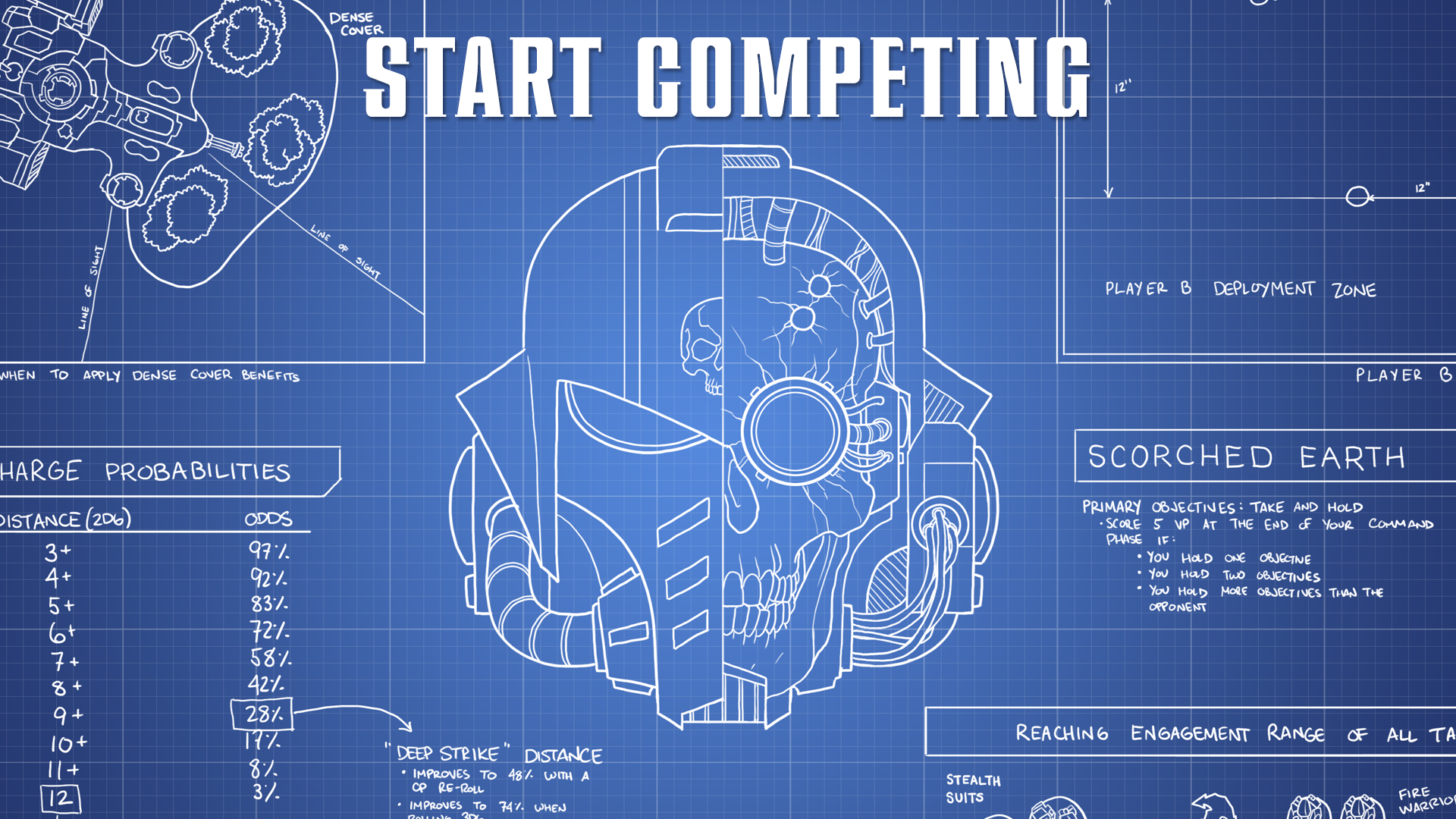The World Team Championships ended last month and before we kick off our recaps of the event from some of the world’s top players, we thought it would be good to run through what team tournaments are in 40k, how they work, and what you need to know about playing in one.
The Tournament Format
When we talk about “Team Events”, what we’re usually referring to is an event where rather than players just matching up in a Swiss fashion, whole teams (which can have a varying number of players depending on the event) get lined up, and the players within the teams get paired up for that round using some form of non-random decision process that the teams have agency in. In general, each game is scored on some sort of differential points system, and the winning team from the matchup is the one that accumulates more points. Finally, there are often limitations on how often a certain codex can show up in each team’s set of lists, meaning you usually see a more diverse field as teams dig beyond tier one to find their armies.
Army Choice

How It Works
Each team at the WTC consists of eight players, and in each team, each Codex can only be represented once, so you have to have at least eight different factions across the team.
What it Means
At its most obvious, this ensures that if one faction is absurdly dominant, you can’t just run eight copies of it and roll through the tournament. It also has a pretty hefty impact on Aeldari and Space Marines in particular – all Marine Supplements draw from the base codex, so you can only include one, and Codex Aeldari containing both Harlequins and Craftworlds means that each can only be used once.
Luckily, in Warzone Nephilim there are a lot of viable armies, so teams have plenty of options to draw on when assembling a fearsome roster, and some builds that wouldn’t cut the mustard in singles play also have a place in teams, as we’ll see later.
Scoring
How It Works
There’s no I in team, and at a team event the team wins or loses as a whole. Each match between teams consists of eight games (with players lined up by a pairings process, which we’ll get to), and each game is scored on a “20-0” system. This means that the winner of each game scores between 11-20 pts for their team’s total, while the loser gets 0-9, depending on the margin of victory.
Any result where the winner is 5VP or fewer ahead is scored as a 10-10 draw. A margin of 6-10VP awards the winner 11pts and the loser 9pts, and for each additional 5VP in the margin after that, another point is awarded, to a maximum of the coveted 20-0 at a 50VP+ margin.
Which team wins is solely decided on points totals, not the number of wins/losses. This means, for example, if one team wins 6 games 11-9, but the other team take the remaining two 20-0, the latter team will win, despite only actually achieving victory in two games.
What it Means
In a singles event, your goal is to win every game, and the margin doesn’t usually matter (though a high absolute VP score for yourself does help with tiebreaks). With 20-0 scoring, two new incentives are introduced:
- You want to achieve crushing victories where possible, racking up more points for your team.
- Being able to force through some points even when you lose still helps your team towards a win.
9th Edition games do sometimes end with 5VP+ margins frequently, but the nature of the scoring means that it’s quite hard to consistently force that. Particularly with some sets of faction Secondaries in Nephilim (*cough* Necrons) it can be very difficult to cap an opponent’s scoring low enough to build up a significant margin, unless you have the perfect counter. It can also change how you want to play some games – if you’re confident that other members of your team have a 20-0 victory lined up, it can better for you to play for a safe 11-9 loss rather than following a risky plan that probably gives you victory, but has a risk of collapsing to a 0-20 loss that cancels out the rest of your team’s work.
All that means that you ideally want as many of your lists as possible facing down against opponents they can crush and where you’re likely to lose a game, for it to at least be by a small margin. The Pairings system is your opportunity to try and make that happen.
Pairings & Terrain

How It Works
Prior to each round, players get to review their opponents full rosters (though since the lists are published weeks in advanced, most come in with a plan for matchups pre-made), and then the pairings process is executed to decide how the eight players from each team pair off, and which tables they will play on. Unlike a lot of singles events, the terrain on every table is not the same – instead, for each round, there are eight different maps with varying levels of terrain on them.
The map pack is available here, and as an example of how maps can differ, take a look at maps seven and five from the first mission, Recover the Relics.

On map seven, all four no-man’s land objectives are very easy to hide on – heck you can even hide a Knight on one on each side. This obviously favours melee armies, and is a major downer for more shooty lists. Map five, on the other hand, is the complete opposite – one objective you can just about toe some infantry in while hidden, but you’re wide open to fast flanking shooting threats – and you’re absolutely not hiding a Lord of War. As you might be guessing, getting a good table for your army can be very advantageous, and forms part of pairing calculations.
We now have all the pieces we need, so lets talk about the pairings themselves. The process is as follows:
- Each team secretly chooses their first “defender” list from among those in their roster. These are revealed.
- Each team then secretly chooses two “attackers” that they’d like to face off against the defenders. These are revealed.
- Teams roll off to decide which team gets to pick their table first, then each team secretly chooses which of the attackers the defender will face.
- These are revealed, and then the teams choose which table the games will happen on, starting with the team that won the roll. That locks in two games, and the other attackers return to the list pool.
- Steps 1-4 are repeated, but with the other team picking their table first. This decides two more games
- Steps 1-4 are repeated, but this time the two attackers that are “refused” (i.e. not picked to face a defender) then face one-another. That leaves one player left in each team, and this forms the final game.
What it Means
Pairings in team events are an art form in themselves, and deeper strategy here is going to form a major part of this series. However, there are some high-level takeaways that crop up across such events:
- Many teams will include lists designed for a “defender” roll. These are armies that can very reliably score points against almost anything, ensuring that at worst they suffer a narrow loss. Eternal Expansionist Necrons is a good example of this. First defender lists also get priority picks of which table to use, so can build the terrain into their game plans.
- Lists that counter a specific matchup very effectively can be much more valuable inclusions in team events. Many of these trade strength in some games for weaknesses in others, and in teams that’s fine – it’s easier to dodge bad matchups, and if you hit a good one the ability to absolutely crush it is valuable for the 20-0.
- Most teams will include at least some “all-comers” lists, usually the best singles list of any given time. If these builds happen to also act as a counter in some matchup, all the better, and you will often see the archetypes chosen from a given faction being those that are good everywhere, and excellent in some games. An example of this is that when Drukhari were dominant with a variety of builds, teams Drukhari lists overwhelmingly used transport-heavy lists, because these tend to act as a great counter for melee armies as well as being strong in their own right. Another valuable feature is excelling on any kind of terrain.
- Individual skew lists are more powerful in teams, but some teams also try to skew on a team level, picking lots of lists that have similar attributes (often defensive ones). An example of this could be picking eight lists that lean heavily on vehicles or monsters, potentially overwhelming the number of counters opponents might have brought for this type of army.
There’s much, much more to get into, and luckily we’ve got some experts lined up to do just that. Stay tuned over the next few days as we have Art of War players from around the globe talk about their experiences and games at the WTC.
Have any questions or feedback? Drop us a note in the comments below or email us at contact@goonhammer.com.


